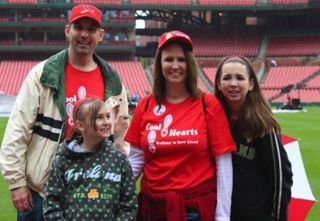She was sitting in the Sacred Heart room at church with the other board member, her six- and eight-year-old daughters across the room coloring, when she slumped over in her seat and fell to the floor. If it wasn’t for the quick thinking of a fellow officer, who is a nurse, she would have died.

Linda Dickson, age 36, was in the midst of a sudden cardiac arrest (SCA). Everyone moved to action. One person called 911, while another checked for a pulse and began cardiopulmonary resuscitation (CPR). The girls were taken to another room. When the ambulance arrived, the paramedics used an automatic external defibrillator (AED) to shock her heart back into rhythm, and rushed her to the hospital.
The National Heart Lung and Blood Institute (NHLBI) defines a SCA as a condition in which the heart suddenly and unexpectedly stops beating. SCA is not the same as a heart attack. A heart attack happens when blood flow to part of the heart muscle is blocked. People with heart disease or have suffered a heart attack are at higher risk for SCA. However, SCA can happen in seemingly healthy people who have no history of heart problems.
The NHLBI lists the most common cause of SCA as ventricular fibrillation, or v-fib, which is a type of arrhythmia. An arrhythmia is a problem with the heart’s electrical system that causes an irregular heartbeat. Other diseases and conditions can cause electrical problems with the heart, such as coronary heart disease, severe physical stress, structural changes in the heart and certain inherited disorders, which are often the cause of SCA in children.
Carissa Caramanis O'Brien, a spokesperson for the Sudden Cardiac Arrest Foundation, tells SciJourner in an email, “Many SCA deaths go unreported and so most agencies, including the [Centers for Disease Control] and others, have struggled in the past to commit to a number. However, it is now accepted that SCA is a leading cause of death in the U.S., claiming more than 295,000 lives annually.”
Most people who suffer a SCA don’t survive to tell their story. According to the American Heart Association (AHA), an estimated 95% of SCA victims die before reaching the hospital.
The NHLBI says that rapid treatment with an AED can be life saving. In cities where defibrillation is provided within five to seven minutes the survival rate goes as high as 35 to 40%. The AHA states that survival is directly linked to the time between the onset of the arrest and defibrillation. Chances of survival are reduced 7 to 10% for every minute of delay.
As a result, there has been a push to put AEDs in public places. An AED is a small computer with adhesive electrode pads that can interpret a heart’s rhythm and deliver an electric shock. The shock from the AED stops the heart long enough to allow the heart to reestablish a regular rhythm on its own.
While AED and CPR training are recommended to work with most public access AEDs, the machines have voice prompts that enable an untrained person to use them. They also have safety features that will detect the regular heart rhythm of a person touching the patient, which prevents the devices from delivering a shock to a healthy person. Nevertheless, there must be a prescription written by a physician overseeing the placement of the AED in a public location. The Philips HeartStart Home OTC Defibrillator – K040904 is currently the only over-the-counter defibrillator approved by the FDA for in-home use.
In Dickson’s case, doctors quickly discovered that a virus had attacked her heart, causing the SCA. She made a full recovery, but an internal cardiac defibrillator was implanted to protect her from another cardiac arrest. She is still healthy four years after the event.
Dickson is now a chairperson for the local chapter of the Sudden Cardiac Arrest Association, working to increase awareness of SCA and raise money to help place AEDs in schools and churches.
Is it worth to place an expensive machine in a school that might never be used? “What is a life worth?” Dickson responds. “If an AED can save just one life, it’s worth it.”
| Related stories: Watch Your Heart!; Michael Jackson: Heart Attack or Cardiac Arrest? |
If you would like to have more information about getting an AED, contact Dickson. Beth GrasserBeth Grasser

This work is licensed under a Creative Commons Attribution-NonCommercial-NoDerivs 3.0 Unported License














Books are your companions, when you are on a journey to access the unknown. Itâ:-??s the biggest education boon to let you know your world.